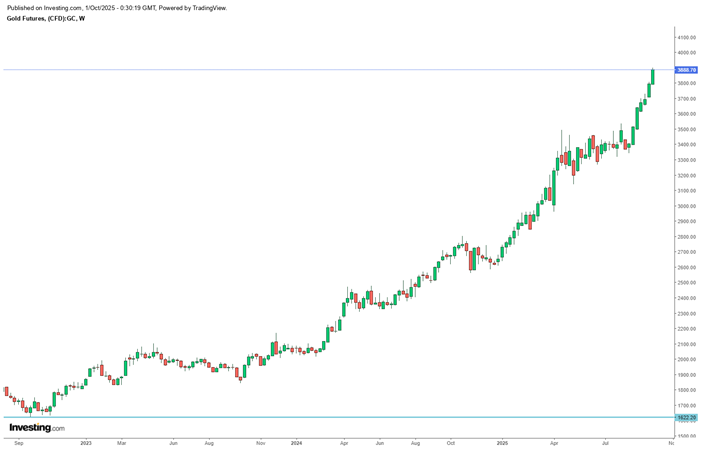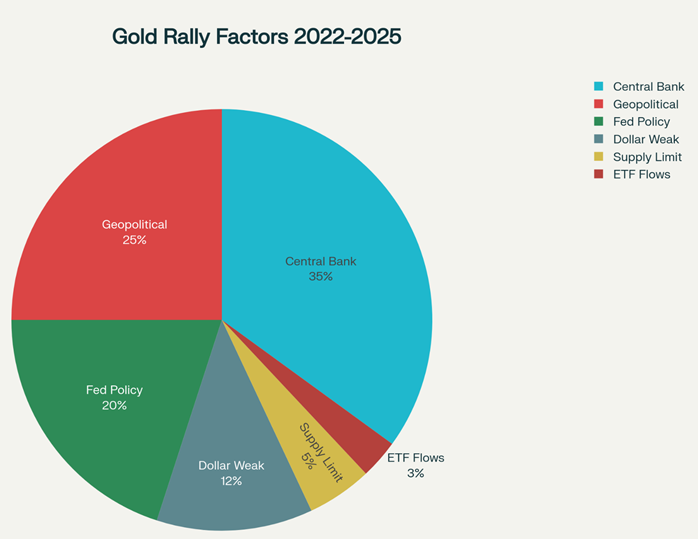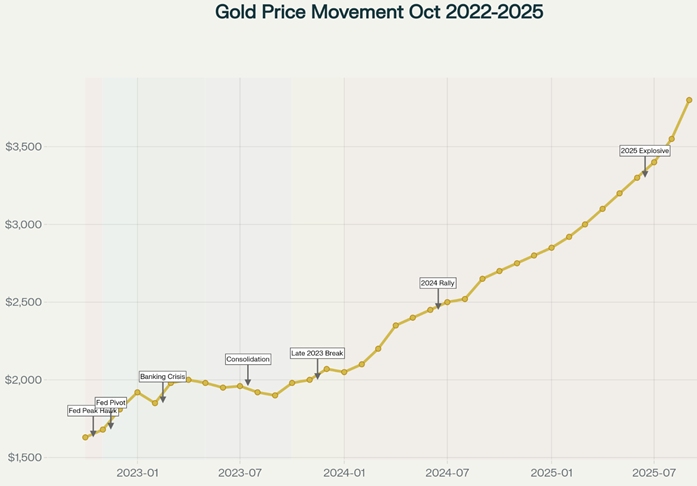Oklo stock tumbles as Financial Times scrutinizes valuation
Three years ago, gold was trading at $1622. The US dollar had reached multi-decade highs above 114, the Federal Reserve was hiking 75 basis points per meeting, and institutional investors were dumping $3 billion worth of gold ETFs. Today, gold sits at $3,863 per ounce, up 137% from those October 2022 lows, and heading toward $4,000. What changed everything?
October 2022: Peak Bearish Conditions
The $1,620-$1,640 range marked gold’s lowest level since early 2020, with three powerful forces converging against the metal. The US Dollar Index reached multi-decade highs not seen since the early 2000s, creating a 45-60% appreciation since 2008 that made gold prohibitively expensive for international buyers and Asian central banks. This US dollar strength coincided with the Federal Reserve’s most aggressive tightening cycle in decades.
The Fed had raised rates from 0.25% to 4.00% through a series of 75 basis point increases in June, July, and September 2022, with another jumbo hike scheduled for November. Real yields surged as markets priced in the possibility that aggressive Fed action might successfully combat inflation, which had reached 15.1% year-over-year in some European regions. Non-yielding assets like gold became extremely unattractive compared to Treasury securities offering positive real returns.
Institutional investors rotated away from precious metals, with gold-backed ETFs experiencing $3 billion in outflows for 2022, per World Gold Council data. Mining companies faced rising energy costs and supply chain disruptions that increased production costs and dampened sector sentiment. The combination looked insurmountable.
November 2022 Fed Pivot: The Inflection Point
The transformation began on November 2, 2022, when the Federal Reserve raised rates 75 basis points to 4.00% but signaled a potential slowdown in future increase pace. Fed Chairman Jerome Powell’s comments suggested the central bank might consider smaller rate increases going forward, marking what markets interpreted as a policy pivot.
This shift sparked the reversal. Economists were warning of a 61% recession probability in 2023, raising concerns about overtightening. The DXY began retreating from October peaks as markets anticipated Fed moderation. Gold’s inverse correlation with the US dollar reasserted itself, providing immediate price relief across global markets.
Simultaneously, central bank buying accelerated dramatically. Official sector purchases reached 459 tonnes in Q3 2022, according to World Gold Council data, shortly after the U.S. froze approximately $300 billion in Russian dollar-denominated reserves. This buying continued through Q4 2022 and intensified through 2023, providing crucial demand support even as investment flows remained negative.
March 2023 Banking Crisis Catalyst
The Silicon Valley Bank collapse in March 2023 proved a turning point for gold’s recovery. The banking crisis undermined confidence in the financial system and triggered safe-haven demand globally. Gold surged 8.28% from February 28 to March 20, reaching $1,989.13 as investors fled banking sector risks across U.S. and European markets.
Credit Suisse’s near-collapse and eventual UBS acquisition further heightened systemic risk concerns across global financial centers. These events validated gold’s traditional crisis hedge role and attracted institutional flows that had been absent since late 2021. The banking turmoil coincided with accelerating Fed dovish signals, creating a favorable environment for continued gains.
By early 2023, the Fed was clearly signaling caution about further rate increases. Market expectations for 2023 rate cuts grew throughout the year, with fed funds futures pricing potential cuts by year-end. 10-year TIPS yields, which had reached 1.5% in October 2022, began falling toward zero and eventually negative territory. This shift made gold more attractive on a real return basis relative to developed market bonds.
Structural Demand Transformation
Previous rallies were driven primarily by cyclical factors. The 2023-2025 advance benefited from structural changes in global gold demand patterns. Central bank purchases evolved from tactical moves to strategic reallocations, with annual purchases exceeding 1,000 tonnes from 2022 through 2024, according to World Gold Council figures.

Key Drivers Behind Gold’s 137% Rally (2022-2025)
The freezing of Russian reserves created lasting "sanctions risk" concerns that convinced central banks worldwide to diversify away from US dollar-denominated assets. This became a permanent feature of reserve management considerations, particularly among nations with geopolitical tensions with Western powers, including emerging market central banks in Asia, the Middle East, and Latin America.
China has led this diversification with systematic intensity. The Bank of China extended its gold buying streak to 10 consecutive months through August 2025, increasing reserves to 74.02 million troy ounces. Gold’s share of China’s total foreign exchange reserves reached a record 7.64%, reflecting deliberate diversification away from U.S. assets.
The BRICS bloc collectively holds approximately 20% of global official gold reserves, with Russia maintaining 2,335 metric tons and China holding 2,279 metric tons. This coordinated accumulation supports broader de-dollarization initiatives, including development of alternative payment systems for international trade settlement. Goldman Sachs analysts project central banks will acquire another 900 tonnes in 2025.
Geopolitical Premium Establishes New Floor
Where 2022 focused on monetary policy, the 2023-2025 period saw geopolitical tensions become primary drivers across global markets. The ongoing Russia-Ukraine conflict maintained elevated risk premiums. The sustained nature of the conflict created persistent safe-haven demand rather than the spike-and-fade pattern typical of acute crises.
Escalating Middle East conflicts, particularly the Israel-Hamas war, added additional risk premiums throughout 2024-2025. These overlapping geopolitical tensions created continuous uncertainty that supported gold regardless of short-term monetary policy fluctuations. Asian and European investors increased physical gold allocations as geopolitical fragmentation intensified.
The Federal Reserve began cutting rates in September 2024, marking the end of the tightening cycle that had pressured gold in 2022. This shift from tightening to easing created a fundamentally different environment for the precious metal. Other major central banks including the European Central Bank and Bank of England also began easing policies, creating global monetary accommodation that favored non-yielding assets.
Supply Constraints Compound Bull Case
Global gold production increased just 3% year-over-year in early 2025, according to mining industry data, while demand from central banks, ETFs, and physical buyers has intensified. This fundamental imbalance has provided consistent upward price pressure across the three-year rally.
Gold-backed ETF holdings reversed 2024 outflows with 107.5 tonnes of inflows in early 2025, according to Bloomberg data. The SPDR Gold Trust (NYSE:GLD) led with 32 tonnes of additions, while strong buying in Germany (15.2 tonnes), the UK (14.1 tonnes), and China (13 tonnes) showed broad-based institutional interest across developed and emerging markets. This marked a sharp reversal from the $3 billion in outflows that characterized the bearish sentiment of 2022.
Mining economics now provide extraordinary profit margins, with average all-in sustaining costs around $1,250 per ounce compared to current prices near $3,800. While this profitability will eventually attract increased production, the typical multi-year lag between price signals and new mine output means supply constraints will persist near-term. The contrast with October 2022, when elevated production costs squeezed margins, could not be more stark.
Risk Factors and Alternative Scenarios
Several developments could disrupt the rally trajectory:
Production Response: Current gold prices provide mining companies with exceptional margins that will inevitably attract capital investment. If production increases outpace demand growth over the next 2-3 years, downward price pressure could build. The mining sector’s response to current prices will prove critical, particularly in emerging gold-producing nations.
Interest Rate Volatility: Should central banks adopt more aggressive tightening to combat persistent inflation, rising real yields could increase gold’s opportunity cost significantly. The Fed’s policy path remains the critical variable. A return to October 2022 rate hike pace appears unlikely but cannot be entirely dismissed.
Geopolitical Resolution: Any material easing of U.S.-China tensions, resolution of the Russia-Ukraine conflict, or stabilization in Middle East tensions could reduce safe-haven demand. Gold’s recent strength partly reflects continuous uncertainty across multiple theaters.
Central Bank Saturation: If major central banks achieve target gold allocation levels, institutional buying pressure could diminish. China’s 7.64% gold allocation remains well below historical peaks, but reaching 10% would substantially reduce incremental demand from the world’s most active official buyer.
Lessons From the Three-Year Recovery
The October 2022 low illustrated how extreme positioning and oversold conditions can create buying opportunities. The 137% rally demonstrates gold’s capacity for dramatic reversals when fundamental conditions shift. Several lessons emerge from this recovery:
Policy Pivot Timing Matters: The Fed’s November 2022 signals marked a crucial inflection point. Gold’s ability to anticipate policy changes rather than simply react to them provided early-positioned investors with substantial returns. Markets discount future conditions, not current ones.
Multiple Driver Strength: Single-factor rallies tend to fade quickly. The 2023-2025 advance was supported by reinforcing factors. Central bank demand, geopolitical tensions, monetary policy shifts, and US dollar weakness created unusual resilience. Multi-factor support indicates durability.
Structural Versus Cyclical: The recovery revealed structural changes in gold demand patterns, particularly from central banks seeking US dollar alternatives. These structural shifts suggest the current bull market may have more staying power than previous cycles driven primarily by cyclical factors like inflation scares or currency crises.
Crisis Validation: The March 2023 banking crisis validated gold’s traditional role during financial stress. Investors who dismissed gold in October 2022 based on rising yields learned that systemic risks can quickly override opportunity cost considerations.
Portfolio Implications
Financial advisors typically recommend 5-10% gold allocation for conservative portfolios, increasing to 10-20% during high inflation periods. Current conditions (elevated inflation, currency debasement concerns, geopolitical fragmentation) support allocations toward the higher end of this range.
The three-year rally shows gold has reestablished itself as a core portfolio component rather than a speculative trade. Physical gold provides direct ownership and eliminates counterparty risk but involves storage costs and 5-10% premiums over spot prices. Gold ETFs offer superior liquidity and lower transaction costs (approximately 0.40% annual expense ratios for major funds like GLD and IAU) but introduce counterparty risk.
Given current overbought technical signals, maintain gold as one component of diversified portfolios rather than concentrated positions.
Forward Catalysts and Outlook
The path to $4,000 may prove volatile, but the fundamental case for gold’s continued strength across the next 12-18 months appears strong. The contrast with October 2022 conditions could not be more pronounced. Where US dollar strength, rising yields, and hawkish Fed policy created maximum bearish pressure three years ago, US dollar weakness, falling real yields, and accommodative policy now provide tailwinds.
Key catalysts to monitor:
- Fed policy decisions and forward guidance (next FOMC meeting December 18)
- China’s central bank’s monthly gold purchase data
- Q4 ETF flow data (released early January)
- Geopolitical developments affecting risk sentiment
- Mining sector production updates
- US Dollar Index movements relative to 2022 highs
Investors maintaining disciplined allocation strategies and appropriate risk management are positioned to benefit from what increasingly appears to be a multi-year structural bull market rather than temporary speculation.
The three-year recovery from October 2022 lows has restored gold’s relevance in modern portfolios amid shifting monetary arrangements and persistent geopolitical fragmentation. A near-term volatility should be expected, but the structural drivers that sparked the 137% rally remain firmly intact.
